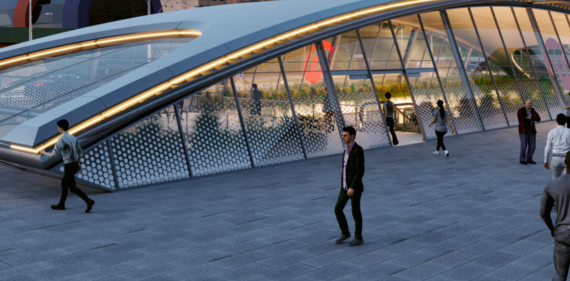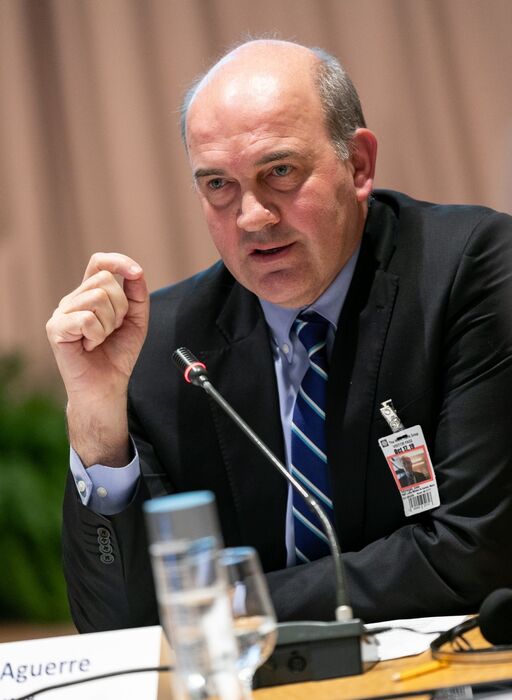
Closing the Infrastructure Gap in Latin American Cities
New gondolas, bus rapid transit systems and the Ciclovia movement are sweeping Latin American cities, positioning them as generators of infrastructure innovation and new practices. Here we interview Agustin Aguerre, who for 17 years served as the director of infrastructure for the Inter-American Development Bank. We explore the challenges that lie ahead to close the urban infrastructure gap across Latin American cities. The interview was conducted by Enrique Pelaez, GGCI Student Research Fellow.
Enrique Pelaez: Why is urban infrastructure a priority investment in Latin America ?
Agustin Aguerre: When we think of urban infrastructure, we usually think of “hard” infrastructure -- roads and rails -- rather than the “soft” urban infrastructure which is needed to create a livable city. We are emerging from an era of bias towards hard infrastructure where progress was measured by the kilometers of roads constructed; and we are now entering into a new era, where we are more focussed on the urban services that infrastructure provides. Infrastructure is now more commonly understood as a means to a social or performative end, so the evaluation of infrastructure’s performance has to be adjusted.
Regarding investment prioritization, I would like to highlight two new concepts. First, infrastructure is the means we get people to work, so it is the way we build economic inclusion and growth. Secondly, infrastructure is the way in which services are conveyed to urban populations in cities and metropolitan areas and since Latin America is one of the most urbanized regions in the world, this is an obvious priority.
Infrastructure has the best multiplier for translating investments into jobs. This linkage has been the subject of many studies and analyses showing the benefits of job creation and increasing income. Infrastructure investments in Latin America have been lagging compared to other parts of the world and therefore our core competitiveness is at risk. We believe Latin America will need to increase its investment in infrastructure from its recent 15-year average of around 2.5% of GDP to above 4% of GDP.
This lack of investment has social impacts. We all remember the recent protests in the streets of Quito and Santiago which centered on quality and pricing of urban infrastructure. There is a growing discontent with the infrastructure status quo. This brings us to the essential question of how we measure and analyze the quality of the urban services provided, as well as the underlying question of who we are planning and building the infrastructure for.
EP: Please expand on this notion of an urban infrastructure gap in Latin America.
AA: We evaluate infrastructure services in terms of access, quality, and affordability. Across Latin America, there has been fantastic progress in the last few years. IDB financed programs have connected 100 million people to the electrical grid in just 15 years. But there is still much investment to be done. 22 million people still have no access to energy services; 28 million people do not have access to potable water.
In terms of access to infrastructure, we need to work in better and more innovative ways, especially in how we finance projects. Connecting to distant populations translates to higher per capita costs of infrastructure and for any politician it is a fantastic goal to make sure that every single citizen has access. So, while we have made good progress, there is more work to be done.
We have many challenges in the quality of service. Is the energy received at a household of constant voltage? Do you have shortages or loss of service? In terms of water, do you have access in your home, or do you need to travel to get potable water? Is the water available 24 hours a day? Is the water provided by a private service? There is a lot of work to be done.
Affordability is the most challenging of all, especially when you assess infrastructure in terms of socially equitable development. Urban infrastructure reveals big inequalities in cities; the poor pay up to 30% of their income to receive services, while the rich pay under 10%. This is why people protest in the streets. At the IDB we have analyzed this extensively and last year we published Development in the Americas (DIA) 2020, a three-year research effort to analyze infrastructure and public service provision.
EP: So what are the implementation challenges?
AA: The first chapter of the challenge is the quantity, quality and efficiency of infrastructure investments. We need to invest more in infrastructure not only because we are coming out of the pandemic, but to improve the long-term quality of urban services. We need increased investments from both governments and the private sector.
We need to increase the quality of investments. Issues of financial transparency and corruption remain big issues in Latin America. At the IDB, we have developed a whole area of work analyzing corruption, how to prevent it, how to create conditions so that it cannot exist and how to solve the problems once they are detected.
The efficiency of project delivery is another key challenge, including the administrative efficiency of transforming budgets into services. Efficiency is affected by both the time it takes to make decisions within the public sector, and by the private markets, where construction companies are not always as efficient or transparent as they could be and should be.
The second major chapter of challenges is climate change. Climate change is forcing us to modify the way in which we conceive and design infrastructure. Mitigation is already part of the DNA of the infrastructure community in Latin America. Today, many countries generate very green energy, such as Uruguay, Costa Rica, and Paraguay.
On the other hand, adaptation forces us to recognize the environmental resources that cities depend on do not behave in the same historical way. We have seen Caracas and São Paulo have huge blackouts because the lakes that power the hydro-generating energy were dry. We have also seen La Paz without running water for months because of receding glaciers. We see coastal roads on Caribbean islands destroyed by winds, hurricanes, and rising sea levels.
So, climate change is here with us and we need to design resilient infrastructure that can stand up to altered weather patterns. This requires re-thinking technical standards used to calculate and model infrastructure and finding additional funding to make infrastructure projects resilient.
The third chapter of challenges is technology. Technology is changing the standards of urban infrastructure and changing the industry and marketplace. In energy, we see the addition of solar and wind energy and we see a big trend in the decentralization of energy generation. Maybe in a few years from now, you will be generating a big portion of the energy at home. You might also be willing to sell excess energy generation to your neighbor or to the grid. This is all very good, but what will happen to distribution companies?
In the transport sector we see autonomous vehicles that are being tested in cities in Latin America including Santiago de Chile and now Bogotá. If we do not own cars but rather use transportation services by an autonomous vehicle company, will the number of vehicles in the streets decrease or increase? Will this change the way cities are designed? Would we be able to reallocate vehicle space to have more trees or more bike lanes? This is something that will change the way in which we live, and the way in which we use our infrastructure.
Additionally, new technologies affect tax systems. More electric vehicles would mean less fuel tax revenues, which is a big revenue source in many countries in Latin America. The need for substitution of this source of income presents, in my opinion, a good opportunity to design a new tax system that can help us guide the conduct of people by generating the correct incentives.
EP: One of the guiding principles at the GGCI is interdisciplinarity, and infrastructure requires coordination among very different fields of expertise. How do you manage interdisciplinary coordination on infrastructure project delivery?
AA: I agree fully, there are no sectoral problems; problems are regional, spatial and place-based. For example, it is of no use solving energy access in the rural areas in Colombia if sanitation is also a problem, or if they cannot transport their production because of the poor state of the roads.
The problem of the silos of governmental competencies is very serious. Most multilateral institutions replicate that structure. At the IDB, I am in charge of infrastructure but I’m not in charge of schools or health, which demand a lot of infrastructure as well. We need to change this approach and we need to learn from each other.
Let me give you an example. I coordinated the development of a huge industrial park in Haiti. One week before launching the bidding process, my environmental colleagues halted the project because they insisted the warehouse foundations be raised four meters to resist flooding. Those four meters increased the project cost by $6 million and delayed the delivery schedule. At first I was against it, but after technical coordination, I accepted it and we raised the level of the foundations. A few years later, huge rains and storms flooded the north of Haiti for months. All was flooded except for the industrial park, which did not stop operations and the 20,000 people employed there didn't stop receiving their paychecks for a single day.
EP: What single projects have been particularly gratifying for you?
AA: The projects I led in Haiti were the most socially sensitive. For those of us who are passionate about human development, that is where you see improvement in people's lives. But talking about one single urban project, I would point to the metro in Quito. It is an infrastructure project that was completed with only 0.5% of cost overruns, with a project budget of almost $4 billion. The metro will transform the city: the way which the city traffic flows, the land value and the way in which people can find work and improve their access to jobs. It was very well planned and organized by the city of Quito, and the results are amazing. Now Quito is arranging a private-public partnership to operate the metro. It is a success story in a country that did not have advanced experience in mega projects; they did an amazing job.
Agustín Aguerre served as director of the IDB's Infrastructure and Energy Sector for more than 17 years. He previously served as IDB’s country manager of Haiti and chief of the Transport Division. He currently serves as the IDB country representative to Argentina.
Before working at the IDB, he worked in both the private and public sectors in Uruguay, where he was chairman of the National Ports Administration, undersecretary of state in the Ministry of Transportation and Public Works, director of the National Roads Agency and chairman of the Institute of Transportation and Infrastructure Planning.
Aguerre holds a civil engineering degree from Uruguay’s Universidad de la República and a MSc. in construction management from the University of Reading.


